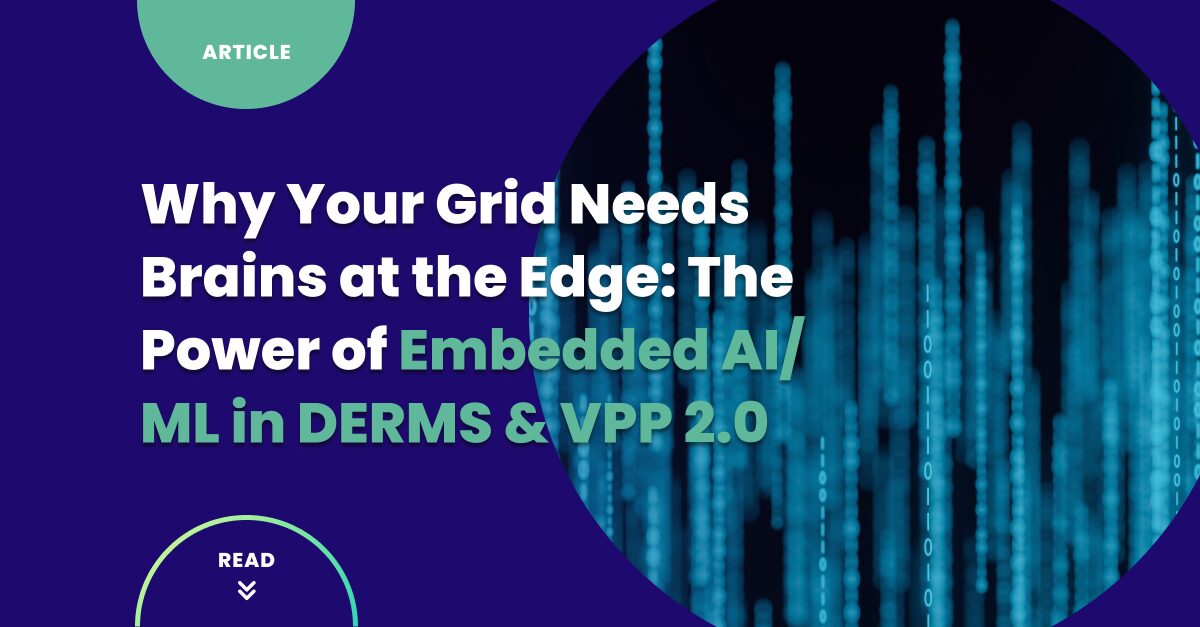Why Your Grid Needs Brains at the Edge: The Power of Embedded AI/ML in DERMS & VPP 2.0

The modern electricity grid is undergoing a fundamental transformation. What was once a centralized, predictable system of large power plants pushing energy in one direction has evolved into a complex, decentralized network. The rise of distributed energy resources (DERs) like rooftop solar panels, smart batteries, and EV chargers is creating an unprecedented volume of data at the grid’s very edge. For legacy, centralized systems, this massive data flow is not a source of intelligence but a bottleneck, overwhelming their capacity and slowing down response times. The rigid, monolithic architectures of yesterday are proving ill-equipped to handle the demand for sub-second telemetry and 5-minute market settlement required by today’s dynamic energy markets.
A new approach is required: one that places intelligence closer to the source of the action. This is the power of embedded intelligence, or Edge AI/ML, in the context of modern Distributed Energy Resource Management Systems and Virtual Power Plants 2.0. Instead of relying on a distant, central cloud to process every piece of data, embedded intelligence runs sophisticated algorithms directly on edge devices. This architectural shift from “dumb” devices to “smart” ones is not just a technological advancement; it’s a strategic imperative for grid stability and efficiency.
Edge AI/ML: The Engine of a Responsive Grid
Placing intelligence at the edge enables real-time, localized decision-making, which is crucial for managing the volatility of renewables. It transforms devices into active participants in grid management, capable of reacting to local conditions autonomously and instantly. This eliminates the communication latency inherent in a centralized model, where data must travel to the cloud and back before a command can be executed. This capability is no longer a luxury. Standards like IEEE 1547-2018 in the U.S. and EN 50549 in the EU are shifting voltage-stability duties to smart inverters and batteries, requiring them to react in under 200 milliseconds to prevent grid instability. Only Edge AI/ML can meet this performance demand.
The Measurable Benefits of Embedded Intelligence
The tangible benefits of this architectural shift are both significant and measurable:
- Optimized Local Forecasting: Edge devices can analyze their own generation and consumption patterns in real time, using on-board AI/ML models to predict future energy availability and needs with greater accuracy than a centralized system could. This localized intelligence allows for more precise load shaping and dispatching, improving efficiency and predictability at the individual and local grid levels.
- Massive Data Reduction: By processing data and making decisions locally, only critical information or commands need to be sent to the central platform. This approach significantly reduces the backhaul traffic, freeing up network bandwidth and making the entire system more efficient and scalable. For example, instead of streaming raw telemetry data every second, the edge device might only send a summary of its operational status or a notification of a significant event.
- Active and Reactive Power Control at the Prosumer Level: As Distribution System Operators begin to enforce active/reactive-power control at the prosumer level, embedded intelligence becomes essential. It enables individual devices to intelligently manage their power output, helping to regulate grid voltage —a critical function that prevents blackouts and maintains grid health.
Building a Resilient, Decentralized Future
Beyond just efficiency and performance, embedded intelligence fundamentally contributes to a more resilient and secure grid. It enables autonomous, decentralized control, allowing devices to continue functioning and supporting local grid stability even if communication with a central system is temporarily lost. This local resilience makes the entire network more robust against both operational failures and cyber threats. Edge AI can also perform predictive maintenance by analyzing equipment data, anticipating failures, and proactively scheduling service, moving grid management from a reactive to a proactive model.
Ultimately, the power of embedded intelligence is only as strong as the software foundation that supports it. To build a robust, intelligent, and scalable grid, organizations require a software layer that facilitates decentralized decision-making. This includes sophisticated AI algorithms, robust cybersecurity measures, and battle-tested communication protocol accelerators that enable seamless integration and control. These foundational elements empower VPPs and DERMS to evolve from simple monitoring tools into dynamic, intelligent orchestration platforms that will enable the green transition and ensure grid stability for decades to come.
